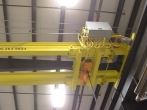 Three important details about load testing
Three important details about load testing
January 7, 2015 REDWIRE is news you can use from leading suppliers. Powered by FRASERS.
Posted by Engineered Lifting Systems & Equipment Inc.
With over 40 years of experience, Engineered Lifting Systems & Equipment Inc. provides standard & custom overhea... Read more
Subscribe
Free REDWIRE e-newsletter

A load test is a physical proof test of a lifting device. During these tests, a lifting device is subjected to a load of up to 125 per cent of its rated capacity and, after the load is released, the lifting device is visually inspected for deformation, cracks or other defects.
Why are these tests necessary, who can perform them and when should they be done? Engineered Lifting Systems addresses these important questions below.
1. Why perform a load test?
A load test verifies the structural and mechanical integrity of the lifting device. The ASME standard B30.20 recommends a load test of up to 125 per cent of the rated capacity for “below the hook” devices. CSA standards B167-96 and B167-64 recommend a load test of up to 125 per cent for cranes. When lifting devices are certified, a drawing of the device with its capacity is typically stamped by a professional engineer, verifying its structural adequacy and compliance with any applicable codes and/or standards.
2. Who can perform a load test?
A load test qualified person — usually a professional engineer — can perform these tests.
3. When should a load test be done?
These tests should be completed after installation of new equipment, or after a piece of equipment has had a major overhaul or modification.
Pricing of a load test is based on various factors, such as the type of machine or equipment, type of installation being reviewed, and technical documentation available. Typically, a quote outlining the scope of the load test is provided before proceeding.
For more information on load testing, contact Engineered Lifting Systems.
Share
Posted by Engineered Lifting Systems & Equipment Inc.
With over 40 years of experience, Engineered Lifting Systems & Equipment Inc. provides standard & custom overhea... Read more